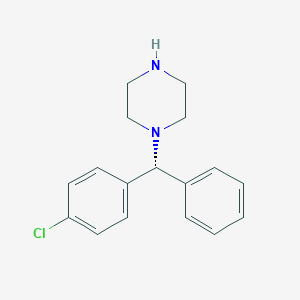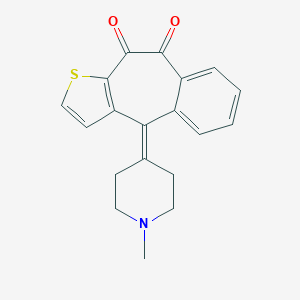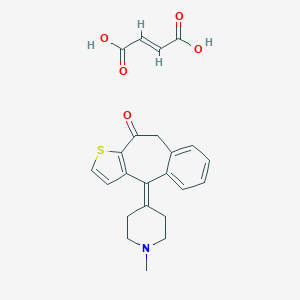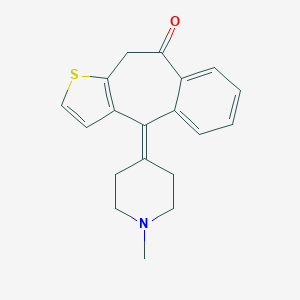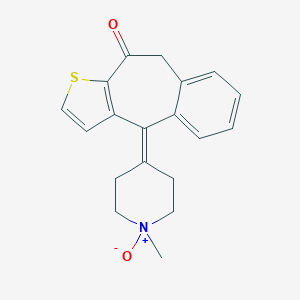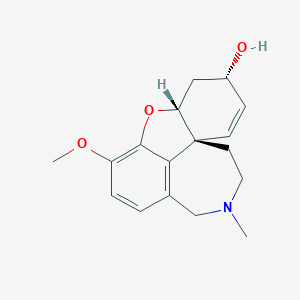
(+)-Galanthamine
Descripción general
Descripción
(+)-Galanthamine is a naturally occurring alkaloid derived from the bulbs and flowers of certain plants in the Amaryllidaceae family, such as the snowdrop (Galanthus species) and daffodil (Narcissus species). It is known for its pharmacological properties, particularly its ability to inhibit acetylcholinesterase, an enzyme that breaks down the neurotransmitter acetylcholine. This makes this compound a valuable compound in the treatment of neurological disorders, such as Alzheimer’s disease.
Métodos De Preparación
Synthetic Routes and Reaction Conditions
The synthesis of (+)-Galanthamine involves several steps, starting from simpler organic molecules. One common synthetic route begins with the compound norbelladine, which undergoes a series of reactions including oxidation, cyclization, and reduction to form the galanthamine structure. The key steps in this synthesis include:
Oxidation: Norbelladine is oxidized to form an imine intermediate.
Cyclization: The imine undergoes cyclization to form a tetrahydroisoquinoline structure.
Reduction: The tetrahydroisoquinoline is reduced to form the final galanthamine structure.
Industrial Production Methods
Industrial production of this compound typically involves extraction from natural sources, such as the bulbs of Galanthus species. The extraction process includes:
Harvesting: Bulbs are harvested and cleaned.
Extraction: The alkaloids are extracted using solvents such as ethanol or methanol.
Purification: The crude extract is purified using techniques like chromatography to isolate this compound.
Análisis De Reacciones Químicas
(+)-Galanthamine undergoes various chemical reactions, including:
Oxidation: It can be oxidized to form galanthamine N-oxide.
Reduction: Reduction of this compound can yield dihydrogalanthamine.
Substitution: It can undergo substitution reactions, particularly at the nitrogen atom, to form various derivatives.
Common reagents and conditions used in these reactions include oxidizing agents like hydrogen peroxide for oxidation, reducing agents like sodium borohydride for reduction, and alkylating agents for substitution reactions. The major products formed from these reactions include galanthamine N-oxide, dihydrogalanthamine, and various substituted derivatives.
Aplicaciones Científicas De Investigación
(+)-Galanthamine has a wide range of scientific research applications, including:
Chemistry: It is used as a chiral building block in the synthesis of other complex molecules.
Biology: It serves as a tool to study the role of acetylcholinesterase in neurotransmission.
Medicine: this compound is used in the treatment of Alzheimer’s disease due to its acetylcholinesterase inhibitory activity. It helps to increase the levels of acetylcholine in the brain, thereby improving cognitive function in patients.
Industry: It is used in the pharmaceutical industry for the development of drugs targeting neurological disorders.
Mecanismo De Acción
The primary mechanism of action of (+)-Galanthamine is the inhibition of acetylcholinesterase, an enzyme responsible for breaking down acetylcholine in the synaptic cleft. By inhibiting this enzyme, this compound increases the concentration of acetylcholine, enhancing cholinergic neurotransmission. This is particularly beneficial in conditions like Alzheimer’s disease, where acetylcholine levels are reduced. Additionally, this compound has been found to interact with nicotinic acetylcholine receptors, further contributing to its therapeutic effects.
Comparación Con Compuestos Similares
(+)-Galanthamine is often compared with other acetylcholinesterase inhibitors, such as donepezil, rivastigmine, and physostigmine. While all these compounds share the common mechanism of inhibiting acetylcholinesterase, this compound is unique due to its dual action on both acetylcholinesterase and nicotinic acetylcholine receptors. This dual action may provide additional therapeutic benefits in the treatment of neurological disorders.
Similar Compounds
Donepezil: Another acetylcholinesterase inhibitor used in the treatment of Alzheimer’s disease.
Rivastigmine: A reversible acetylcholinesterase inhibitor also used for Alzheimer’s disease.
Physostigmine: A reversible inhibitor of acetylcholinesterase, used in the treatment of glaucoma and myasthenia gravis.
Propiedades
IUPAC Name |
(1R,12R,14S)-9-methoxy-4-methyl-11-oxa-4-azatetracyclo[8.6.1.01,12.06,17]heptadeca-6(17),7,9,15-tetraen-14-ol | |
|---|---|---|
| Source | PubChem | |
| URL | https://pubchem.ncbi.nlm.nih.gov | |
| Description | Data deposited in or computed by PubChem | |
InChI |
InChI=1S/C17H21NO3/c1-18-8-7-17-6-5-12(19)9-14(17)21-16-13(20-2)4-3-11(10-18)15(16)17/h3-6,12,14,19H,7-10H2,1-2H3/t12-,14-,17-/m1/s1 | |
| Source | PubChem | |
| URL | https://pubchem.ncbi.nlm.nih.gov | |
| Description | Data deposited in or computed by PubChem | |
InChI Key |
ASUTZQLVASHGKV-SUYBPPKGSA-N | |
| Source | PubChem | |
| URL | https://pubchem.ncbi.nlm.nih.gov | |
| Description | Data deposited in or computed by PubChem | |
Canonical SMILES |
CN1CCC23C=CC(CC2OC4=C(C=CC(=C34)C1)OC)O | |
| Source | PubChem | |
| URL | https://pubchem.ncbi.nlm.nih.gov | |
| Description | Data deposited in or computed by PubChem | |
Isomeric SMILES |
CN1CC[C@]23C=C[C@H](C[C@H]2OC4=C(C=CC(=C34)C1)OC)O | |
| Source | PubChem | |
| URL | https://pubchem.ncbi.nlm.nih.gov | |
| Description | Data deposited in or computed by PubChem | |
Molecular Formula |
C17H21NO3 | |
| Source | PubChem | |
| URL | https://pubchem.ncbi.nlm.nih.gov | |
| Description | Data deposited in or computed by PubChem | |
Molecular Weight |
287.35 g/mol | |
| Source | PubChem | |
| URL | https://pubchem.ncbi.nlm.nih.gov | |
| Description | Data deposited in or computed by PubChem | |
CAS No. |
60384-53-4 | |
| Record name | Galanthamine, (+)- | |
| Source | ChemIDplus | |
| URL | https://pubchem.ncbi.nlm.nih.gov/substance/?source=chemidplus&sourceid=0060384534 | |
| Description | ChemIDplus is a free, web search system that provides access to the structure and nomenclature authority files used for the identification of chemical substances cited in National Library of Medicine (NLM) databases, including the TOXNET system. | |
| Record name | GALANTAMINE, (+)- | |
| Source | FDA Global Substance Registration System (GSRS) | |
| URL | https://gsrs.ncats.nih.gov/ginas/app/beta/substances/8L3T05AQ82 | |
| Description | The FDA Global Substance Registration System (GSRS) enables the efficient and accurate exchange of information on what substances are in regulated products. Instead of relying on names, which vary across regulatory domains, countries, and regions, the GSRS knowledge base makes it possible for substances to be defined by standardized, scientific descriptions. | |
| Explanation | Unless otherwise noted, the contents of the FDA website (www.fda.gov), both text and graphics, are not copyrighted. They are in the public domain and may be republished, reprinted and otherwise used freely by anyone without the need to obtain permission from FDA. Credit to the U.S. Food and Drug Administration as the source is appreciated but not required. | |
Synthesis routes and methods I
Procedure details












Synthesis routes and methods II
Procedure details











Retrosynthesis Analysis
AI-Powered Synthesis Planning: Our tool employs the Template_relevance Pistachio, Template_relevance Bkms_metabolic, Template_relevance Pistachio_ringbreaker, Template_relevance Reaxys, Template_relevance Reaxys_biocatalysis model, leveraging a vast database of chemical reactions to predict feasible synthetic routes.
One-Step Synthesis Focus: Specifically designed for one-step synthesis, it provides concise and direct routes for your target compounds, streamlining the synthesis process.
Accurate Predictions: Utilizing the extensive PISTACHIO, BKMS_METABOLIC, PISTACHIO_RINGBREAKER, REAXYS, REAXYS_BIOCATALYSIS database, our tool offers high-accuracy predictions, reflecting the latest in chemical research and data.
Strategy Settings
| Precursor scoring | Relevance Heuristic |
|---|---|
| Min. plausibility | 0.01 |
| Model | Template_relevance |
| Template Set | Pistachio/Bkms_metabolic/Pistachio_ringbreaker/Reaxys/Reaxys_biocatalysis |
| Top-N result to add to graph | 6 |
Feasible Synthetic Routes
Descargo de responsabilidad e información sobre productos de investigación in vitro
Tenga en cuenta que todos los artículos e información de productos presentados en BenchChem están destinados únicamente con fines informativos. Los productos disponibles para la compra en BenchChem están diseñados específicamente para estudios in vitro, que se realizan fuera de organismos vivos. Los estudios in vitro, derivados del término latino "in vidrio", involucran experimentos realizados en entornos de laboratorio controlados utilizando células o tejidos. Es importante tener en cuenta que estos productos no se clasifican como medicamentos y no han recibido la aprobación de la FDA para la prevención, tratamiento o cura de ninguna condición médica, dolencia o enfermedad. Debemos enfatizar que cualquier forma de introducción corporal de estos productos en humanos o animales está estrictamente prohibida por ley. Es esencial adherirse a estas pautas para garantizar el cumplimiento de los estándares legales y éticos en la investigación y experimentación.
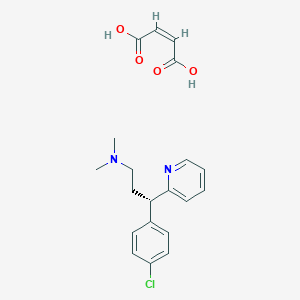

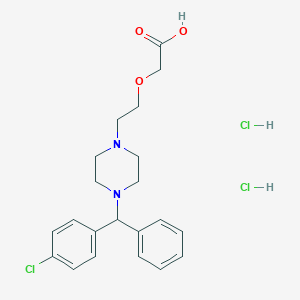
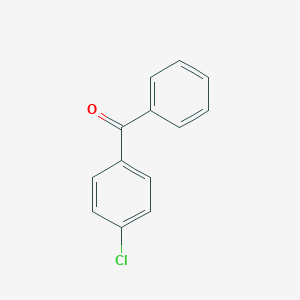

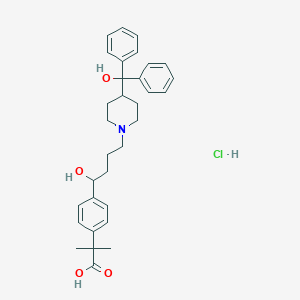
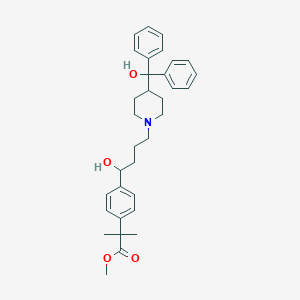
![1,4-Bis[(4-chlorophenyl)phenylmethyl]piperazine dihydrochloride](/img/structure/B192774.png)
